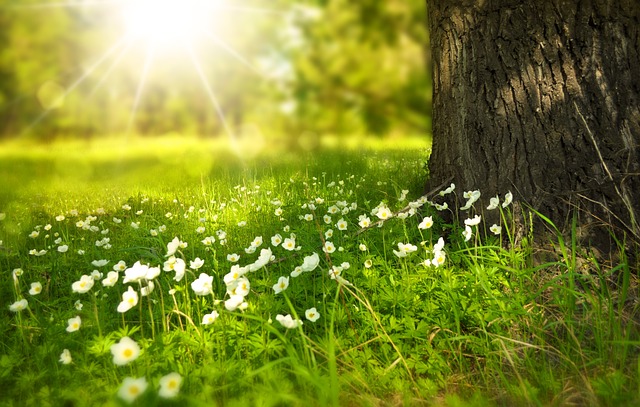When we think of creative writing, our minds often wander to the grandiose and mythical: soaring mountains, crashing waves, and starry nights. Yet amidst this backdrop of extraordinary landscapes, we often overlook the subtle beauty that lies beneath our very feet – the humble grass. This unsung hero of the natural world is not only a foundation for countless ecosystems but also a muse for poets, storytellers, and artists throughout the ages. Journey with us as we explore the vivid language and enchanting imagery that the grass inspires in the realm of creative writing, unearthing the earthly whispers that have woven their way into our literary tapestry.
Contents
- Earthly Whispers: Describing the Delicate Blades of Grass in Creative Writing
- Unveiling the Subtle Beauty: Exploring the Intricate Shades and Textures of Grass
- The Symphony of Grass: Capturing the Gentle Rustling and Whistling Sounds in Words
- A Dance in the Wind: Depicting the Graceful Movement and Swaying of Grass
- The Aroma of Nature: Describing the Earthy, Fresh Fragrance of Verdant Grass
- Enhancing Your Writing: Tips and Techniques for Evocative Grass Descriptions
- Exploring Techniques for Evocative Grass Descriptions
- Bringing the Outdoors to Life: Invigorating Your Prose with Lively Grass Imagery
- Frequently Asked Questions
- Concluding Remarks
Earthly Whispers: Describing the Delicate Blades of Grass in Creative Writing
When it comes to creative writing, the world of nature serves as a boundless source of inspiration. Among the gentlest wonders that Earth has to offer are the delicate blades of grass that carpet our landscapes, silently adding a touch of tranquility to our lives. Describing the mesmerizing allure of these tiny plants can wonderfully enhance your writing, connecting readers to the beauty that lies beneath their feet. Allow your words to depict the lushness of grass, its hidden secrets waiting to be unveiled.
Start by imagining a sea of emerald green perfectly swaying in the wind, whispering sweet stories only decipherable by the curious observer. Picture the slender blades, sprouting effortlessly, inching their way upward towards the sun, each one a testament to resilience and tenacity. To capture its essence, consider evoking emotions that arise from its presence; it symbolizes renewal, refreshment, and the cycle of life. Employ vivid imagery to paint a vivid mental picture in the minds of your readers, allowing them to feel the gentle touch as they walk barefoot through a meadow, blades tickling the soles of their feet.
Unveiling the Subtle Beauty: Exploring the Intricate Shades and Textures of Grass
Grass, a seemingly ordinary part of our surroundings, often goes unnoticed and underappreciated. However, upon closer examination, one can unveil the hidden beauty that lies within this fascinating plant kingdom. With its diverse shades and textures, grass has so much more to offer than meets the eye.
Step into the enchanting world of grass and prepare to be mesmerized by its intricate shades. From vibrant emerald greens to subtle hints of olive, grass showcases a stunning palette of colors that evolve throughout the seasons. Whether it’s the fresh spring grass glistening with dewdrops or the rich, deep green of summer lawns, each hue has a unique story to tell as nature gracefully unfolds. This diverse array of colors brings harmony and life to our surroundings, creating a sense of tranquility and serenity.
The Textures:
Beyond its breathtaking shades, grass offers a world of intricate textures that effortlessly captivate our senses. Explore the velvety softness of a well-manicured lawn, where each blade of grass stands tall and equally pristine. Run your fingers over the fine, lush strands, delighting in their gentle caress against your skin.
But grass doesn’t limit itself to a single texture. Discover the playful variety as you encounter patches of rough and coarse grasses, adding a dynamic contrast to the landscape. Picture yourself walking barefoot on a dew-kissed meadow, feeling the ticklish sensation of sprawling, long blades gently brushing against your toes. The textures of grass serve as nature’s intricate tapestry, inviting us to connect with the Earth on a deeper level.
The Symphony of Grass: Capturing the Gentle Rustling and Whistling Sounds in Words
Just imagine strolling through a vast, green meadow, a gentle breeze brushing against your skin, and the orchestra of sounds that unveils as you step onto the lush carpet of grass. The symphony of this natural wonder is often overshadowed by the grandeur of other natural elements, but if one truly pays attention, the delicate rustling and whistling of grass blades can transport us to a tranquil and serene world. Let’s dive into the captivating nuances of this verdant orchestra and attempt to capture its essence through the artful arrangement of words.
The rustling sound of grass, like the soft whispers of secrets between friends, carries an air of delicate mystery. It is a symphony created by countless individual grass blades as they sway in the wind, effortlessly harmonizing their movements. The varying lengths, thicknesses, and textures of these blades contribute to the richness of the auditory experience. As each blade collides, brushing against its neighboring companions, a gentle chorus rises. It is a symphony that oscillates between a gentle hush and a playful whisper, reminiscent of the passage of time or even the circadian rhythm of nature herself.
- Subtle whistles: Amidst the rustles, the grass occasionally emits faint whistles, as if whispering secrets only audible to the keenest of listeners. These ethereal sounds, weaved into the fabric of the symphony, add an enchanting layer of detail to this performance of whispers.
- Seasonal variations: The symphony of grass is not static but is ever-changing, influenced by the seasons themselves. In the meadows of spring, the rustling may arise jubilantly, mimicking the delightful laughter of a flourishing ecosystem. However, in the serenades of winter, the grass may whisper more solemnly, as if sharing tales of stoicism and resilience.
A Dance in the Wind: Depicting the Graceful Movement and Swaying of Grass
Nature has always been an endless source of inspiration, captivating the human mind with its enchanting beauty. One such mesmerizing sight is that of grass gently swaying in the wind, gracefully dancing to the rhythm of nature’s symphony. The fluid motion and elegance portrayed by the blades of grass as they bend and twist create an ethereal spectacle, a true masterpiece of nature’s artistry.
The graceful movement and swaying of grass serves as a reminder of the delicate balance and harmony that exists within the natural world. Each blade, unique in its position and length, contributes to the overall choreography of this mystical dance in the wind. As the gentle breeze touches the surface, the blades respond, creating a mesmerizing visual display, too beautiful to be put into words.
The dance of the grass showcases the intricate connection between the elements of the environment. It symbolizes the delicate interplay of wind, sunlight, and soil, each playing a vital role in nurturing and sustaining this elegant spectacle. The wind acts as the conductor, leading the blades in a synchronized rhythm while allowing them to express their individuality. The warm embrace of sunlight provides the energy needed, propelling this dance forward, while the soil, the steadfast foundation, supports and anchors every movement.
It is in this harmonious movement of the grass that we witness the gentle power of nature and its ability to evoke a sense of peace and tranquility within us. Observing the dance in the wind, we are reminded of the interconnectedness of all living things and the beauty that comes from embracing diversity and allowing each unique element to contribute to the symphony of life. Just as the grass sways, we too should strive to move through life gracefully and adapt to the changing winds with resilience, always finding beauty in the dance.
The Aroma of Nature: Describing the Earthy, Fresh Fragrance of Verdant Grass
The aroma of nature is a symphony for our olfactory senses, encompassing a myriad of captivating scents. Among them, the earthy, fresh fragrance of verdant grass stands out as a quintessential embodiment of the natural world. This distinct aroma transports us to idyllic landscapes, where blankets of lush green grass stretch out beneath open skies, beckoning us to indulge in its sensory allure.
Let’s embark on a sensory journey and explore the elements that contribute to the intoxicating scent of verdant grass:
- Chemical compounds: The distinct smell of grass is a result of several chemical compounds released by the plant. The most prominent one is geosmin, a microbial byproduct that lends earthy undertones to the aroma. Additionally, terpenes and pyrazines contribute to the fresh, green notes.
- Chlorophyll: The vibrant color of grass, derived from chlorophyll, is not only visually pleasing but also contributes to its fragrance. This essential pigment undergoes a process called volatile breakdown, releasing compounds that add to the sweet, hay-like scent of freshly mown grass.
- Nature’s breath: The verdant grasses of meadows and lawns interact with the surrounding environment, absorbing and releasing scents. These natural surroundings infuse the grass fragrance with hints of wildflowers, tree sap, and even the subtle muskiness of damp soil after a rainfall.
The aroma of verdant grass is nature’s poetry, a fragrant ode to the beauty of the Earth. Take a moment to immerse yourself in its earthy splendor and let the essence of the grass transport you to a tranquil place where the scent of the natural world revitalizes the spirit.
Enhancing Your Writing: Tips and Techniques for Evocative Grass Descriptions
Exploring Techniques for Evocative Grass Descriptions
When it comes to capturing the essence of nature in your writing, the humble grass can be a powerful tool. Whether you’re a writer looking to add depth to your descriptions, or simply a nature enthusiast wanting to enhance your observations, these tips and techniques will help you create evocative grass descriptions that transport your readers to lush meadows and sun-kissed fields.
- Engage the senses: To make your grass descriptions truly come alive, evoke all five senses in your writing. Describe the soft touch of the blades against the skin, the earthy scent after a summer rain, the vibrant green hues dancing beneath the sunlight, the gentle rustling sound with each passing breeze — these details will immerse your readers in the natural world.
- Select powerful adjectives: Choose specific and vivid adjectives to breathe life into your grass descriptions. Instead of “green,” opt for “lush,” “emerald,” or “verdant.” Replace “ordinary” with “exquisite” or “enchanting.” Experiment with a variety of adjectives to find the ones that best convey the mood or atmosphere you are aiming for.
- Use metaphors and similes: Comparing grass to other objects or phenomena can add depth and interest to your descriptions. For example, you could liken the way grass bends in the wind to a graceful dancer, or compare its softness to a baby’s blanket. Metaphors and similes offer a fresh perspective and help readers visualize the grass in a unique and memorable way.
By incorporating these techniques into your writing, you’ll transform simple grass descriptions into vivid, sensory experiences that captivate your readers. So, grab your pen or open your word processor, and let your imagination wander through the sprawling fields of grass, ready to be beautifully depicted in your next piece of writing.
Bringing the Outdoors to Life: Invigorating Your Prose with Lively Grass Imagery
When it comes to writing vividly, incorporating the imagery of lush green grass can transport your readers to refreshing outdoor landscapes. By infusing your prose with lively grass imagery, you can invigorate your writing, adding depth and sensory appeal. Here are a few tips to help you bring this element to life in your writing:
- Powerful metaphors: Comparing the vibrancy of a character or a situation to a verdant field of grass creates a striking visual image that leaves a lasting impression on your readers. It can convey the idea of growth, vitality, and abundance, injecting energy into your narrative.
- Evoking sensations: Describing the feel of grass beneath one’s feet or the gentle rustle as the wind playfully caresses the blades can enhance the sensory experience for your readers. This tactile imagery allows them to connect on a deeper level, immersing themselves in your writing.
- Symbolic landscapes: Grass-covered landscapes can signify themes such as renewal, rebirth, or even hidden dangers lurking beneath a seemingly calm surface. Utilizing such imagery in a symbolic context can convey meanings beyond the literal, adding layers of complexity to your storytelling.
By incorporating lively grass imagery into your prose, you breathe life into your writing, adding an organic touch that engages your readers on a profound level. Whether you use it as a metaphor, to evoke sensations, or to convey deeper meanings, the grass becomes more than just green blades. It becomes a powerful tool to infuse your writing with energy, inviting your readers to walk barefoot on the lush landscapes of your imagination.
Frequently Asked Questions
Q: What is the purpose of the article “Earthly Whispers: Describing Grass in Creative Writing”?
A: The purpose of this article is to provide writers with creative and effective ways to describe grass in their writing, helping them paint vivid images and engage readers on a deeper level.
Q: Why is it important to be able to describe grass effectively in creative writing?
A: Grass is a common element in outdoor settings and natural landscapes, making it a frequently mentioned subject in various pieces of writing. By developing the skill to describe grass with creativity and precision, writers can capture the essence of a scene and transport readers into the world they are creating.
Q: How can describing grass enhance the overall quality of creative writing?
A: By describing grass in compelling ways, writers can bring texture, color, and movement to their scenes. Such details help establish a sensory experience for readers, making it easier for them to visualize and immerse themselves in the story or setting.
Q: What are some techniques that can be used to describe grass effectively?
A: There are several techniques that writers can employ to describe grass creatively. These include using sensory language, employing metaphors or similes, exploring variations in color and texture, and highlighting the role of grass in specific environments or seasons.
Q: How can sensory language be utilized in describing grass?
A: Sensory language involves appealing to the reader’s senses, so when describing grass, a writer might capture the softness of the blades underfoot, the earthy aroma it emits, the sound of a gentle breeze rustling through it, or the sight of dew droplets glistening on its surface. Engaging multiple senses adds depth and richness to the imagery.
Q: Can you provide an example of a metaphor or simile that can be used to depict grass?
A: Certainly! For instance, one might describe grass as a “lush green carpet,” emphasizing its vibrant and uniform appearance. Another example is comparing grass to “nature’s paintbrush,” suggesting its ability to beautify landscapes and add splashes of color.
Q: How can variations in color and texture be used to describe grass?
A: Grass can have many shades of green, from emerald to olive or lime. By exploring these variations, writers can create a more nuanced and compelling description. Texture can also vary greatly, from coarse blades to soft, velvety patches. Describing these aspects can evoke different moods or feelings associated with grass.
Q: In what ways can grass be tied to specific environments or seasons?
A: Grass can serve as a representation of the environment it thrives in. For example, tall, wild grass gently swaying in the breeze may evoke images of meadows or countryside settings, while short and perfectly manicured grass may be associated with well-maintained city parks or gardens. By linking grass to its surroundings, writers can add depth to their descriptions.
Q: Any final tips for writers looking to excel in the art of describing grass?
A: Practice is key. Engage in observation exercises to familiarize yourself with the details of grass and experiment with different descriptive approaches. Additionally, reading and studying the works of seasoned writers who skillfully depict natural environments can offer inspiration and insights to further enhance your descriptive abilities. Remember, practice and exposure to different writing styles are essential in sharpening your craft.
Concluding Remarks
In conclusion, “Earthly Whispers” highlights the importance of capturing the essence of grass in creative writing, allowing readers to connect with nature on a deeper level.






